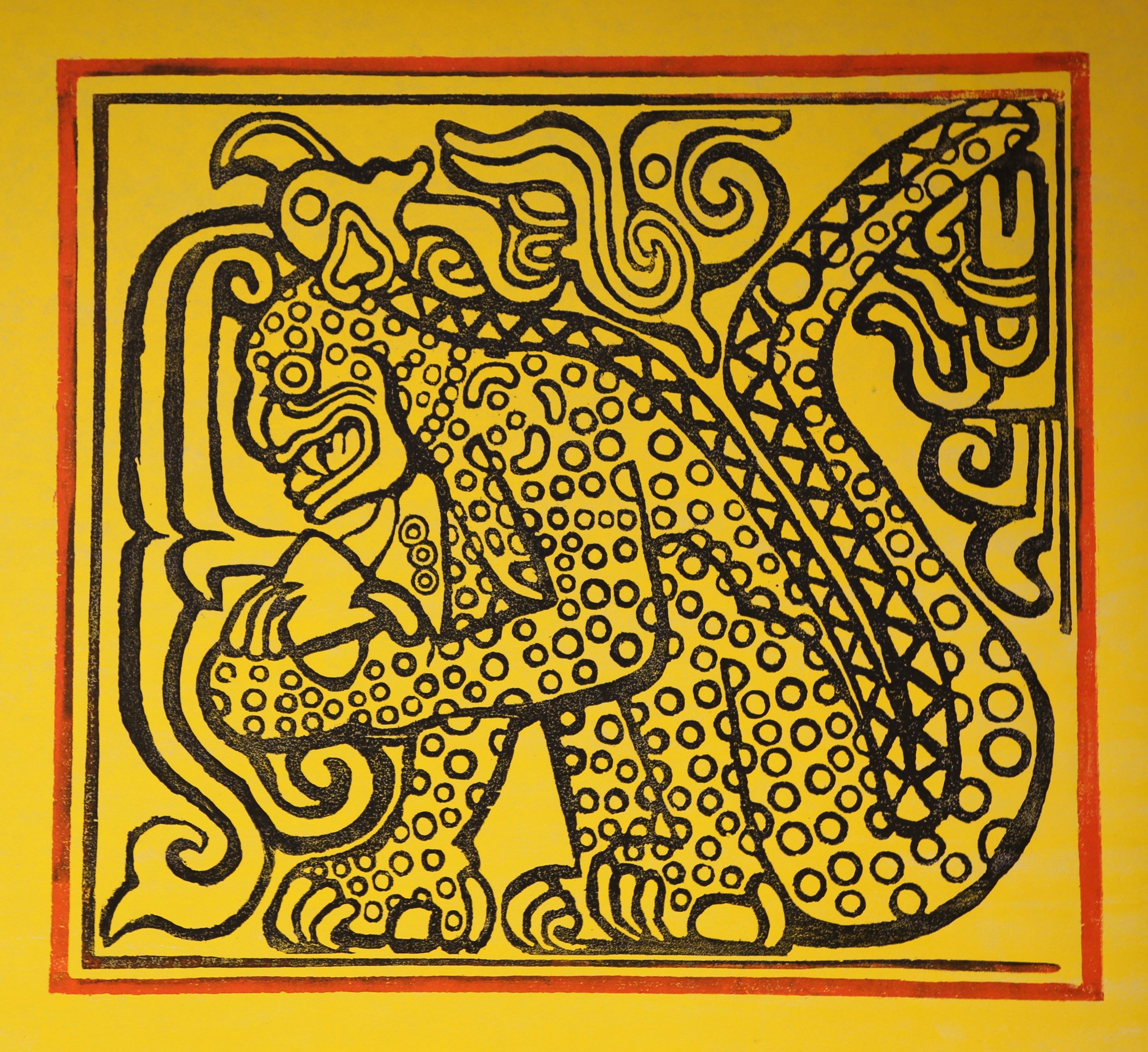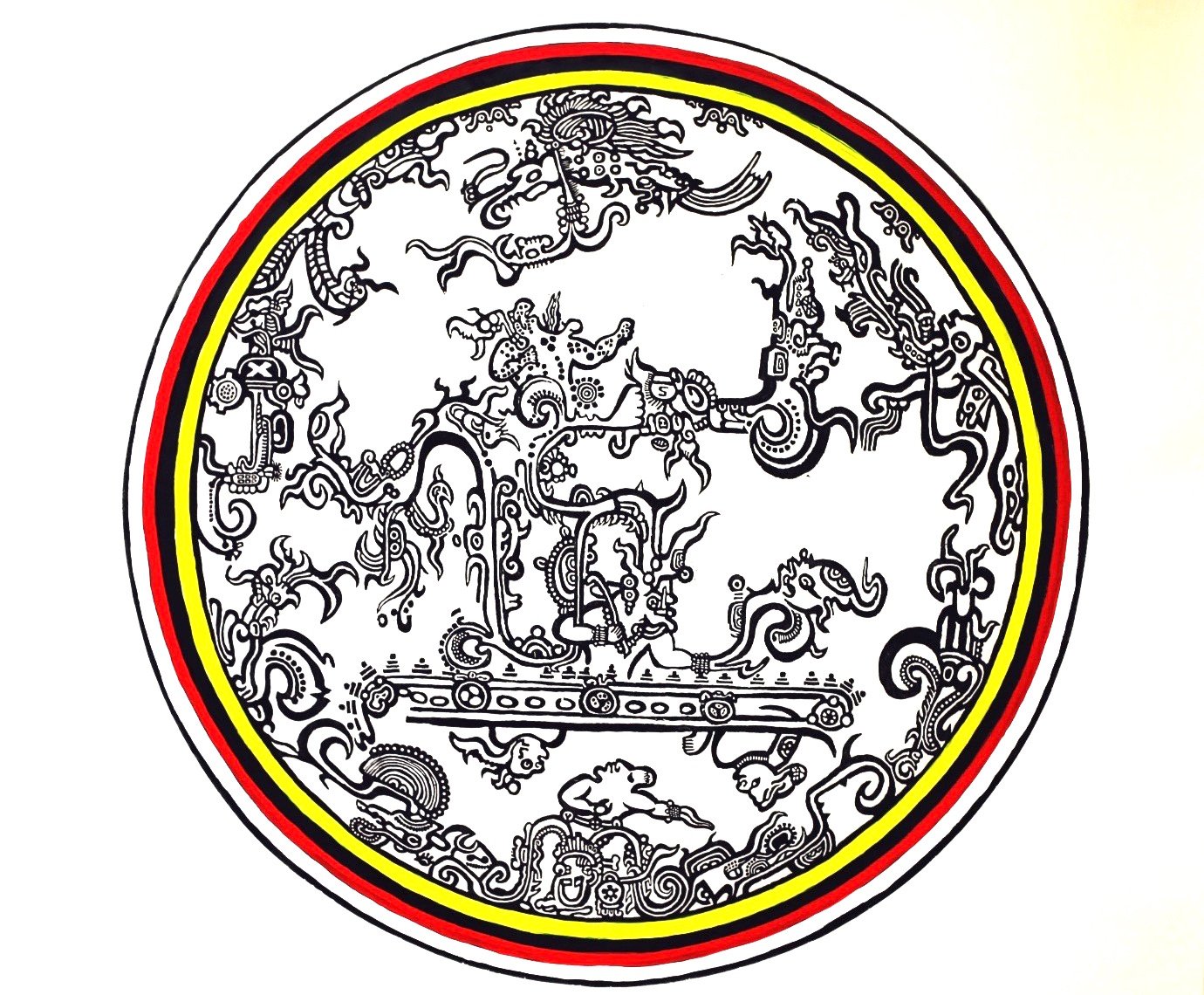
The transaction, is between artist-seller and buyer without mediator.
The Work of this Portfolio, is all for sale. If you are interested in buying, jus send an email, introducing yourself and indicating the title of the artwork that you are interested and I will be answered as soon as possible.
Thank you for visit and, have a wonderful day.
This Woodcuts Print Portfolio, of Pre-Colombian Mayan Images “From The Dead Of One Star” is a professional collection of more than 20 Pre-Colombian woodcut prints. This project has given me the opportunity to advance in my artistic practice step by step but, even more, it provided a profound reencounter with my cultural Mestizo roots and with the element of wood; a constant element I have had in my hands since my childhood.

"The Sacred Tree of Life for the Mayas" Woodcuts (block) print, 60X60 inch, oil on pellon, 2022. “When the world was created, a pillar was placed in the sky ... which was the white tree of abundance to the north, then the Black tree of abundance was laid to the west ... Afterwards, the red tree of abundance was laid to the east ... Then the yellow tree of abundance was set in the south ... Then the great green tree (Ceiba ) Of abundance was placed in the center. "

"Hunahpu's battle at Xibalba" Popol-Vuh "God of Fertility and the Mayan Ball Game" Woodcuts print 48x24 inch, (oil on Pellon) 2022 The deity of the sun is represented as well as a jaguar. The father of the twin heroes Hunahpú and Ixbalanqué, Hun-Hunahpu was called 'Hun Nal Ye' during the classical era and according to the Mayan Chronicles. It was this story of Hunahpú the god of fertility and the ball game, son of the gods, counters of days, and ash diviners Ixpiyacoc and Ixmucané, and father of the gods twin heroes Hunahpú and Ixbalanqué.

Handprints made in soot or earth colors can be seen in some places of our world, occupied by ancient peoples, many millenniums ago. The simple idea of a carved block of wood, whit the design covered in ink and pressed on to a sheet of paper is at the very heart of civilization: the replication of text and illustration spread knowledge, power and religion quickly. From northern China printing spread along the Silk road to the Mediterranean and on to the New World, ruled in ancient times by the great Mayan, Olmecas, Toltecas, Incas and Aztecan peoples.

"Mayan Calendar" Woodcuts Print 20X22 inch, oil on pellon, 2022. The Mayas in the central Mesoamerican area (Central America) begin their chronological count of time 600 years before the Gregorian Calendar, according to the European chronological correlation. The count of the Mayas apparently begins on August 6, 613 B.C. and in the Civil Calendar, in a very clear way, the Mayan count begins in 580 B.C. when the month 0 Pop, it coincides with the winter solstice. Early period from: 176 A.D, until 373 A.D, 9.0.0.0.0 to 9.10.0.0.0 (Urban Planning) During these 10 Katuns (First Empire) the extraordinary cities of the South Mesoamerican, made a rapid ascent towards the assembly of the great pyramids with their divine temples built. The extraordinary use of Hieroglyphs in monumental inscriptions was very characteristic during the First Period of Maya history. Time later, writing is reduced to Books. (Spinden, J. Herbert, 1928. Pages, 123 – 125)

"God of Numbers Twenty" Woodcuts Print, Oil on Pellon, 20 X 22 inch, The glyph is written on a tablet of Palenque, the figure on the left side represents the god of the number Ten, the sign that identifies this god, is the human skeleton that carries on his head, representing the God of Death. The fantastic figure on the right side represents the birth of Katuns = 20 years. Chiapas, classic period.

"Mayan Ball Game Marker" 40" diameters Woodcuts Print, oil on pellon, 40 inches diameter. This Marker of the ball playing field shows; the double feathered serpent and the Mayan ball marker in the center of the as goal.

"The Chinkultic Disc" 2022, Woodcut print, oil on pellon, 40 inch, diameter. The original Chinkultic Disc Chiapas, Maya early classic period 591 A.D., Limestone 56 cm. (diameter) x 13 cm. (thickness) National Museum of Anthropology, Mexico City. This Marker shows the moment in which the player is striking the ball with his hip. He wears a protective belt, some kneepads, and a protection on his front arm. His elaborate headdress has a waterfall of feathers in the back. Around the edge of the disk the remarked circle symbolizing output and setting of the equinox. The 12 images around the disc are symbolizing the deities of the underworld, "Xibalbá - Mictlán"

"Cosmic Disc/Plate from Piedras Negras" Woodcuts Print, Oil on Pellon, 40 inches diameters, 2018. The sky of this carving image had the general shape and body marks of the cosmic crocodile, but they also show deer hooves, the familiar deer ear, and sometimes deer antlers on the forehead. This is also the largest Mayan site to the west of Tikal, including Palenque. The name "Piedras Negras", which means "Black Stones", was given due to the color of the stones used in this site.
Relief Printing, has been used by famous artist as well as anonymous illustrators, the relief printing, it can be delicate and subtle, or bold and colorful. It was the method of printing used for all books and newspapers until this century. Now while is commercial use is rare, the basic idea thrives in the hands of printmakers who have developed and refine the techniques leading to a revival that is noticeable everywhere.
As an input, I share the title of one important book, for those who may want to start as a printmaker. 
"The Jaguar Sun God Maya" Woodcut Print 20 X 22 inch, Oil on Pellon, Decoration at the Temple of Eagles and Jaguars in Chichen Itza, Yucatan. In the raised stone panels of this temple there are embossed images of Eagles, while in the sunken are the Jaguars with beautifully marked shields. Both animals are devouring the human heart and refer to the journey of the sun through the vault of the sky during the day and its decent in the underworld at night. The eagles and jaguars are directly related to the warriors, whose duty was to take prisoners to be sacrificed in honor of the Sun God. Maya-Toltec Period, 975-1200 A.D.

"God of Numbers Maya" Woodcut Print, 20 X 22 inch, oil on pellon, 2022. The glyph of God of Numbers is carve on the left side of the entrance of the Palace of the Palenque, Chiapas, is the figure that represents the god of the numbers. The period of time that most interested the Mayans was that of Katún representing the cycle of 20 years. The Mayan calendar is organized so that the Katun can end only on the day called Ahau. This piece is a clear example of the carved glyph of the original figure, in the Palenque Palace Mexico.

"Cosmic Disc/Plate from Piedras Negras" Woodcuts Print, Oil on Pellon, 40 inches diameters, 2018. The sky of this carving image had the general shape and body marks of the cosmic crocodile, but they also show deer hooves, the familiar deer ear, and sometimes deer antlers on the forehead. This is also the largest Mayan site to the west of Tikal, including Palenque. The name "Piedras Negras", which means "Black Stones", was given due to the color of the stones used in this site.

The reason for the survival of relief printing over two thousand years is its versatility. You can use beautifully prepared block of a rare wood, but you can also rescue a piece of driftwood to cut into a wood block. You can also use the finest handmade paper to print on, but you can also print on quite ordinary paper. You do not need much equipment – a table to work on, the traditional wood carving chisel, plus one knife, a simple rubber roller and a wooden spoon to burnish the impression – it involves no great outlay to start a series of experiments in relief printmaking. Later you may well be intrigued with the possibilities and want to acquire a printing press, but remember that the ancient woodblock print were printed without a press, only by hand – burnishing.
Many materials other than wood are now used, giving a wide choice in both price and availability. People who are unable to use the solvents and chemicals essential and other printmaking methods (Oil Base) will find that relief prints can be made with non – toxic substances and the solvent can be water.

